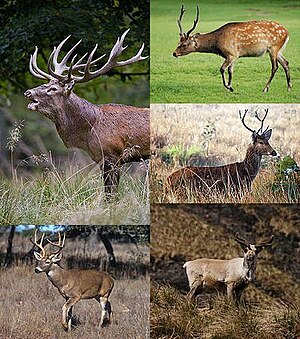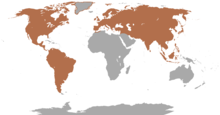Cervidae
| Deer Temporal range: Early Oligocene–Recent |
|
|---|---|
 |
|
| Images of a few members of the family Cervidae (clockwise from top left) consisting of the red deer, the sika deer, the barasingha, the reindeer, and the white-tailed deer. | |
| Scientific classification | |
| Kingdom: | Animalia |
| Phylum: | Chordata |
| Class: | Mammalia |
| Order: | Artiodactyla |
| Infraorder: | Pecora |
| Family: |
Cervidae Goldfuss, 1820 |
| Subfamilies | |
 |
|
| Combined native range of all species of deer | |
Capreolinae
Cervinae
Hydropotinae
Deer (singular and plural) are the ruminant mammals forming the family Cervidae. The two main groups are the Cervinae, including the muntjac, the fallow deer and the chital, and the Capreolinae, including the elk, reindeer (caribou), the Western roe deer, and the Eurasian elk (moose). Female reindeer, and male deer of all species (except the Chinese water deer), grow and shed new antlers each year. In this they differ from permanently horned antelope, which are in the same order, Artiodactyla.
The musk deer of Asia and water chevrotain (or mouse deer) of tropical African and Asian forests are not usually regarded as true deer and form their own families: Moschidae and Tragulidae, respectively.
Deer appear in art from Palaeolithic cave paintings onwards, and they have played a role in mythology, religion, and literature throughout history, as well as in heraldry. Their economic importance includes the use of their meat as venison, their skins as soft, strong buckskin, and their antlers as handles for knives. Deer hunting has been a popular sport since at least the Middle Ages, and remains an important business today.
...
Wikipedia
